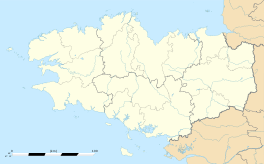Hoëdic
| Hoëdic Edig | |
|---|---|
|
An aerial view of Hoëdic | |
 Hoëdic | |
|
Location within Brittany region  Hoëdic | |
| Coordinates: 47°20′25″N 2°52′40″W / 47.3403°N 2.8778°WCoordinates: 47°20′25″N 2°52′40″W / 47.3403°N 2.8778°W | |
| Country | France |
| Region | Brittany |
| Department | Morbihan |
| Arrondissement | Lorient |
| Canton | Quiberon |
| Government | |
| • Mayor (2008—2014) | André Blanchet |
| Area1 | 2.08 km2 (0.80 sq mi) |
| Population (1999)2 | 117 |
| • Density | 56/km2 (150/sq mi) |
| Time zone | CET (UTC+1) |
| • Summer (DST) | CEST (UTC+2) |
| INSEE/Postal code | 56085 / 56170 |
| Elevation |
0–22 m (0–72 ft) (avg. 14 m or 46 ft) |
|
1 French Land Register data, which excludes lakes, ponds, glaciers > 1 km² (0.386 sq mi or 247 acres) and river estuaries. 2 Population without double counting: residents of multiple communes (e.g., students and military personnel) only counted once. | |
Hoëdic (officially Hœdic, in Breton: Edig) is an island off the south coast of Brittany in north-western France. Its bigger "twin sister" island is Houat.
Administratively, Hoëdic is a commune in the Morbihan department.
Geography
This island, 800 m wide and 2,500 long, stretches over two square kilometers. It is located in the heart of Mor braz, in the Atlantic Ocean, off the south coast of Brittany (Rhuys and Quiberon peninsulas), 13 km east of Belle-Île and 5 km South-east of Houat. It is part of a line of granite crests which also includes the peninsula of Croisic, Dumet Island, Houat, Quiberon and Groix.
Hoëdic is a low, undulating plateau; It reaches its maximum altitude (22 meters) in the middle of its eastern part (on the road that currently leads from the village to the hamlet of the Phare). Its base consists essentially of granite and less often of schists. The coast is an alternation of sandy coves and rocky points of variable height, generally more marked to the north (Beg Lagat, the Old Castle ...) than to the South (Beg Er Faut, Kasperakiz). There are two marshes, one modest, behind the dune of the new harbor, the other, about twenty hectares behind the dune of the old port. In addition to the main island, the town has several small islands (essentially to the south-east) including Roc'h Melen, Madavoar, Cardinals, Mulons ...
Human Geography
Long Hoëdic has associated the polyculture (livestock and gardens) with the fishery resource. The first disappeared in the middle of the twentieth century, while the second, after a second wind in the 1980s, tends to lose speed today. Much more than its neighbor Houat, it is largely dependent on tourism. Like its neighbor, the greater part of its surface is now subjected to the invasion of brush.
Hoëdic is a car-free island with a hundred inhabitants in winter . In summer, the population can reach 3,000 with boaters, tourists and campers coming to the island. The island is connected to the mainland all year round by Compagnie Océane boats and Compagnie des Iles boats during the tourist season (connections from Quiberon).
Demographics
Inhabitants of Hoëdic are called Hoëdicais.
See also
References
External links
| Wikimedia Commons has media related to Hoëdic. |
- Getting there (French)
- French Ministry of Culture list for Hœdic (French)
- Map of Hœdic on Michelin (English)
